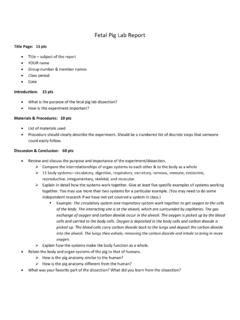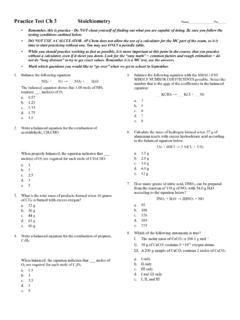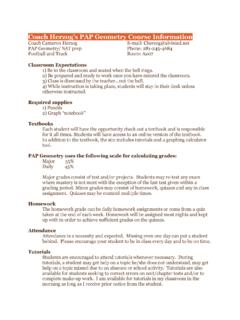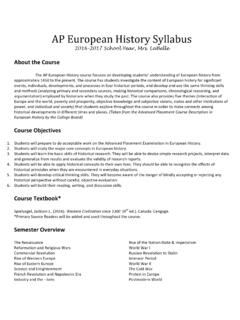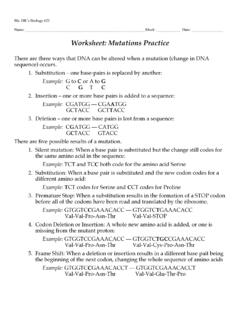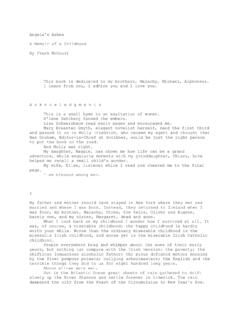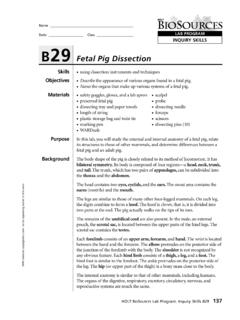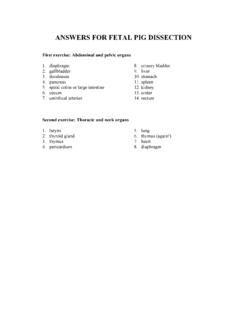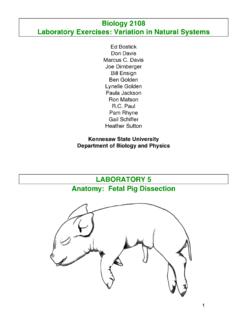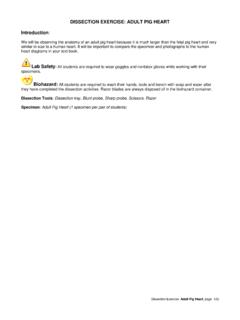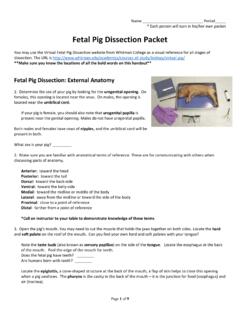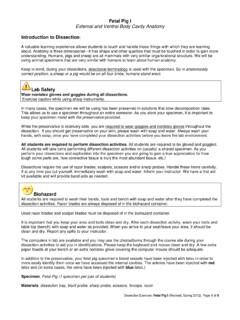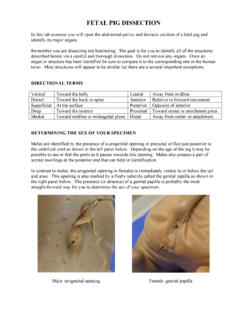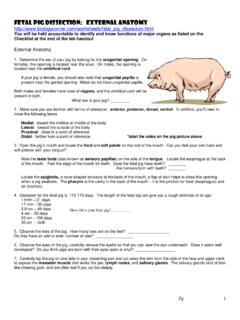Transcription of Pig Dissection Lab Packet - Alvin Independent …
1 1 Pig Dissection Lab Packet Teacher _____ Period _____ Group # _____ Chief Surgeon: _____ Assistant Surgeon: _____ Recorder: _____ Materials Manager: _____ 2 Dissection Laboratory Procedures Materials: You will use the same materials for the entire Dissection . You will check out materials at the beginning of each period and return materials at the end of each period. Your group is responsible for the well being and cleanliness of these materials. Dissecting tray Dissecting tools - Scalpel - Scissors - Forceps - Blunt Probe - Needle Probe Preserved rat Goggles for each person Gloves for each person Aprons Lab Manual Lab Packet Pen/Pencil Beginning of each Dissection day: Materials Manager obtains the rat and gloves, and Dissection materials.
2 Each person obtains goggles and an apron. During each Dissection : Follow specific instructions for each Dissection section Read all directions before beginning Cut as little as possible!! Keep in mind that you are dissecting not butchering. Any cuts will alter the original structural relationships. There will be a daily lab grade, straying from your task will result in your losing points on your rat lab. End of each Dissection day: Wrap pig in skin and return to plastic bag; save all the dissecting fluid. Surgeons clean and dry lab tray & tools and work area, clean out the sink at your lab station. Complete normal lab clean up (check your group activity/lab guidelines) Replace goggles, aprons and wash hands!
3 !! Safety 1. Follow all instructions. 2. NEVER eat, drink, or chew anything in lab. 3. Never spray cologne or perfume in lab. 4. Never run, push, throw objects or engage in horseplay. 5. Report All accidents or injuries immediately. 6. Use equipment only as directed and only when permission is given. 7. Keep floors clear. 8. Do not leave your experiment unattended. 9. Wash hands with soap and water before leaving lab. 10. Know location and operation of safety equipment. 11. Always cut away from you and down on the tray. 12. Razors, scalpels, dissecting needles, and other sharp instruments MUST be carried in a tray or protective container. 13. Shoes with closed heels and toes must be worn in the lab.
4 14. Tie back long hair. 15. Do not wear bulky or loose fitting clothes and remove loose jewelry. 16. Protective goggles, apron, and gloves must be worn properly. 17. Be aware of where others are located around you. 18. Do not talk with your hands if you have sharp instruments in them. 3 Dissecting A Mammal- fetal Pig Introduction: In this lab you will be examining many characteristics of an unborn mammal--the fetal pig. Dissection will help you to get a 3-dimensional picture of how all the systems fit together in an entire organism. You've seen separate diagrams of many of the major systems. Now you'll get to see how they are all arranged spatially. You'll also get a better idea of the texture of many organs that make up the pig's system.
5 This lab will be divided into the following lab components: #1- External Anatomy #5- Respiratory System #2- Oral Cavity #6- Urogenital System #3- Digestive System #7- Nervous System #4- Circulatory System Materials: preserved fetal pig, dissecting pan, scissors, forceps, blunt probe, twine/string, safety goggles, one pair of disposable latex gloves per Dissection day, tape measure. General Directions: All underlined words must be located on your pig and all numbered questions must be answered on each of your packets. Your teacher will check the questions as you work through the laboratories. Most cuts can be done with the scissors. Dissection is an art and you must carefully dissect without destroying your pig.
6 Keep all parts with your pig! Pig Lab #1 - External Anatomy - see figures on pkt and 15 1st-You will be examining several characteristics of an unborn mammal. Use Packet page 13 to review the directional names for the pig. The period of gestation for the pig is 112-115 days. 2nd- The age of the fetus can be estimated by measuring the body length from the tip of the snout to the attachment of the tail on the pig s dorsal side. Compare this length to the data given on relative sizes of a fetal pig at different times during gestation or the time of development inside the uterus. (mm = millimeters) 21 days : 11 mm 56 days : 40 mm 35 days : 17 mm 100 days: 220 mm 49 days : 28 mm 115 days: 300 mm Generally speaking, mammals are recognized and classified by their external appearance.
7 The external features which separate mammals into orders include: the number of digits (toes or fingers) on the feet, method of walking or other locomotion, and characteristics of the teeth. Mammals have two unique, external characteristics which distinguish them from all other vertebrates: (1) all mammals have hair at some time during their development (2) all female mammals possess mammary glands with external openings for nourishing offspring with milk. Your fetal pig probably does not have a lot of hair due to the fact that it is not fully developed yet. However, at maturity most pigs do have hair. The lips around the mouth are well developed and the upper lip has a groove called the philtrum.
8 Humans also have a philtrum. This is the indent underneath your nose and just above your upper lip. The external nares (nostrils) are found on the nose. Examine the ears. They have a flexible outer flap called the pinna. The pinna helps the pig hear by focusing the sound into the middle ear. 4 Many mammals have sensory facial hairs called vibrissae; however, our pigs do not possess these yet. They are evident once a pig reaches maturity. They help organisms feel their way around in the dark. Vibrissae of dogs and cats are commonly called whiskers. 3rd- Examine the eyes. They have an upper and lower lid and a small mass of tissue in the upper corner known as the nictitating membrane.
9 This membrane helps keep the eye clean. Birds can moisten their eyes in flight using this membrane and not blinking; blinking could cause a collision with a branch or tree. 4th- Examine the feet. The pig is called unguligrade because it walks on its hooves. Humans are plantigrade because we walk on the entire soles of the foot. Dogs and cats are digitigrade because they walk on their digits. In pigs, the first digit of both the fore and hind limb is absent and the second and fifth are reduced in size but remain functional. 5th- The pig's trunk is divided into two regions: thorax (chest) and abdomen (stomach). Examine the umbilical cord. Observe that it contains three blood vessels: a large vein (blue) and two smaller arteries (red).
10 Observe the paired row of nipples on the ventral surface of the abdomen in both sexes. The actual number of nipples varies from mammal to mammal. Animals that have litters tend to have more nipples. Pig Gender Determination Information The penis and urethral opening of the male pig are located posterior to the umbilical cord on the pig s ventral surface. If your pig is young, the scrotal sacs (ventral to the tail and anus) may still be empty, as the testes descend just before birth. If you have a more mature male, the testes will have descended to fill the scrotum. If the pig is female, you will notice a small projection just below her tail. The opening immediately ventral to her tail is the anus; the opening ventral to the anus, associated with the small projection, is the vaginal opening.
